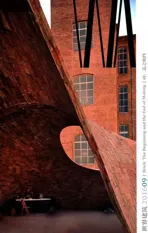卡里扎克公寓楼,德黑兰,伊朗
2016-10-19建筑设计卡艾特工作室
建筑设计:卡艾特工作室
Architects: Caat Studio
卡里扎克公寓楼,德黑兰,伊朗
Kahrizak Residential, Tehran, Iran, 2015
建筑设计:卡艾特工作室
Architects: Caat Studio
德黑兰地区的居民主要都是低收入的移民工薪阶层。由于其人口构成的特点,这个区域的文化较为保守。在建造住宅时,他们更看重的也是数量而非质量。因此这里甚至有些公寓的卧室没有窗户,既晒不到太阳也看不到风景。这类住宅由于其低廉的价格,往往销售得更多更快。
这个项目在找到建筑师之前,有几层结构已经建成,而且客户遇到了严峻的资金困难。建筑位于一块方形地段,各边长都为18m。其另外三面都与周围的建筑紧贴,只有南立面能够敞开。每层包含4套50m2的公寓。在这样的条件下,最好的解决方式就是聚焦于朝南的公寓,关注南立面和城市界面的关系,同时也要在限制条件下改善朝北公寓的居住条件。
项目的首要考虑是造价限制,因此关键性的答案就是使用源于当地的材料。最终我们选择了砖——在地段附近就有制砖厂,而且当地的建筑工人也熟悉砌砖的方法。另外,住户的生活方式与该地区的建造方式有巨大的差异,例如街区中的阳台作为一项立面常规功能,就并未得到充分使用。
那里的住户有不同的空间要求,他们通过最简单的方式按各自需要对空间进行改造。他们用石墙或是彩色玻璃把阳台封闭起来,从而晾晒衣服、储存物品,甚至把泡菜罐子存放在那里。
项目的核心概念就是寻求一种让建筑师、建造方和客户紧密合作的方式,从而缩小造价,并考量当地文化以及住户的生活方式。
从这一概念出发,我们在充分理解各方需求之后,提出了这一设计:一座卡里扎克的新型住宅楼,一座满足当地居民需求的建筑。砖,首先是一种廉价材料,其次它作为基本模数和成比例的材料,拥有很多优点,方便创造出多种变体。我们的设计策略是,为南立面背后的每个空间设计相应的砖砌单元,让室内获得充足的日照以及储物空间。
砖砌单元根据伊朗传统几何图样设计,每个单元都优先保证背后空间的功能。尽管砖砌单元有多个变体,但它们的语汇能产生共鸣。由此形成的平滑立面既能代表伊朗的砖建筑,又能表达建筑住户的生活。另外一个值得考虑的问题是,我们希望挖掘当地砌砖工人的潜力。他们擅长用砖,而且能够轻易地理解通过不同排砖方式所产生的几何形式。(黄华青 译)

1 立面/Facade
The population of this region are mostly working class immigrants with low incomes. Due to its population dynamics the area has a conservative culture. When it comes to shelter, what matters is rather quantity rather than quality. As a result, even there are some residential flats with windowless bedrooms lacking both sunlight and view. These buildings are purchased more and faster because of low prices.
The project was delegated to the architect in a situation that a couple of structural levels were built adding that the client had real budget limits. It was located in a square shaped lot, with 18m length each side. All three sides of the building were blocked but the southern elevation. Each story of project contains four residential units with 50m2unit area. Best solution evolved in conditions described, was to focus on units facing south and the interaction between southern elevation and the urban facade and of course the improvement of units facing north considering their limitations.
The foremost consideration was the budget,therefore the key answer was the use
of regional materials. We came up with brick as our solution:There were brick factories nearby and also regional workmen were familiar with bricks. Secondly, there was a huge gap of residents' lifestyles and the types of constructions in the area. For example, balconies in the neighborhood, as a routine function in the facade were misused.
People there needed different spatial requirements; they were adapting their spaces to their needs with basic solutions. They were blocking the balconies with masonry or even colorful glass,to hang their clothes, store their stuffs, or even have their pickle jars stored there.
The main concept of this project is to offer a close collaboration between the architects,constructor sand the client, within minimum cost budget and taking local culture and lifestyles of the residents into account.
That is where we started to think about a design, with understanding all those needs, to a new alternative residential building in Kahrizak. A building to fit in the requirements of local residents. Brick, firstly as inexpensive material and secondly as a modular and proportional material which has many advantages in order to create different alternatives. The design strategy was to provide each space behind the southern facade with proper brickwork modules to let sufficient daylight come in with sufficient storage space.
Brick modules were designed based on Iranian geometrical pattern; each module was subservient by the function of the space behind it. Also with varieties in brick modules, they were speaking same language. That's how it resulted in a smooth facade,to resemble both Iranian brick architecture and residentially of the building. Another point to be considered is that we wanted to take the advantage of local workmen, that were skilled in using brick and they could easily perceive the geometry used in the brick arrangement.
项目信息/Credits and Data
客户/Client: 私人/Private
建筑用途/Building's Purpose: 低预算住宅/Low budget apartments
建筑面积/Usable Floor Area: 1660m2
砖材类型/Brick Type: 饰面砖/Facing bricks
建造周期/Construction Period: 2012.05 – 2015.03
摄影/Photos: Parham Taghioff (fig.1,4), Ashkan Radnia (fig.2)
评论
张雷:住宅设计对砖建造的运用,为德黑兰地区满足平民需求低造价建设提供了一种可选择的模式,对地方材料,和地方工匠传统的尊重,结合设计与经济考量,使得朴素的功能需求获得了应有的尊严,延续传统建造活动也被激发出内在的活力。
建筑南向唯一的城市景观界面覆盖地方出产的红砖,并且由地方工匠手工操作完成。尽管其几何呈现是纯粹的当代数字化“设计”特征,但同样易于被地方文化认同,这得益于其遵从了当地的气候、传统的材料和建造的原生逻辑,进而完成了当代语境下新的诠释。项目在经济运行方面的极大成功揭示了一个基本的、却易于被当代建筑师忽视的问题,在大多情况下,建筑是生活的场景而不仅是自我欣赏的艺术展示品。
袁烽:卡里扎克公寓楼在城市关系层面采用网格化的立面处理方式形成了整个沿街立面的连贯性。在每一个网格单元中,建筑师将参数化逻辑思维与砖石建构方式进行结合形成了对伊朗传统砌筑图案的当代呈现,从视觉体验上对伊朗地域文化进行了回应。同时,建筑师对每个网格内砌筑单元体的形态设计将几何、材料与性能联系起来,不同砖石形态在立面上的分布一方面产生了丰富的视觉效果,另一方面也实现了室内居住空间采光的最优化处理。整个建筑由于在一定程度上受到造价的限制,只能以低技的手工砌筑方式进行实现,然而这种低技建造过程中所体现的手工艺从另一个侧面体现了当地特有的文化背景和地域现状。这种现状与高技的参数设计思维相结合形成了一种特殊的参数化地域主义。

2 光影/Light and shadow
Comments
ZHANG Lei: The application to the bricks in residential design provides the residents in Tehran with an alternative to meet the need of local people for buildings of low cost. In regard of local materials and local artisan traditions along with economic considerations, such application endows dignity to simply functional requirements, and gives rise to the inherent vitality of the continuation of traditional architecture.
The only interface looking southward to the urban landscape is covered with homemade bricks, and built up manually by local craftsmen. Although its geometrical representation is featured with purely contemporary digital design, it also brings remarkable identity of local culture. Thanks to its accordance with traditional inherent logic of climate, material and construction, the new interpretation under the contemporary context is completed. The great success of the project in economic operation reveals a fundamental issue usually ignored by contemporary architects: in most cases, the architecture is a scenario of life instead of only an art exhibit of selfappreciation.
Philip F. Yuan: Kahrizak Residential maintains the continuity of the street's context by introducing a grid facade system. However, within each grid cell, the architect manipulates the brickwork through differing parametric rules, establishing a contemporary representation of Iranian geometric patterns and creates a dialogue with the local traditional culture. The geometry of the grid cells is furthermore associated with material and environmental performance. Each parametric brick assembly not only produces an attractive visual effect, but also optimizes the natural lighting of the rooms behind the grid facade. Due to the limited construction budget,the complex geometry of each grid cell could only be achieved through low-tech methods. However, the authentic handicraft found in the building process reveals the cultural background and situation of the region. To some extent, the association of the low-tech masonry assembly and the high-tech parametric design thinking establishes a new architecture paradigm – parametric regionalism.

3 剖面/Section

4 内景/Interior view
